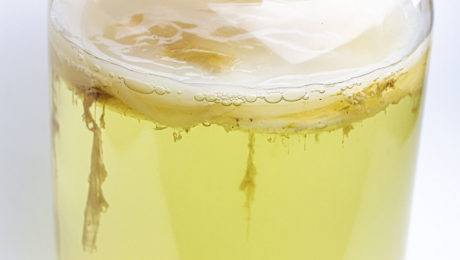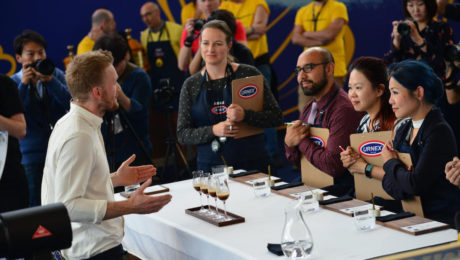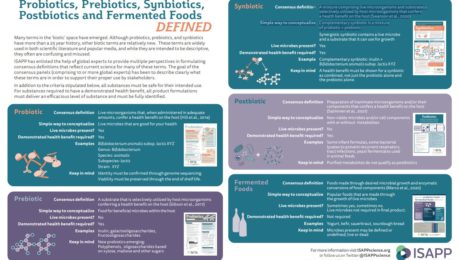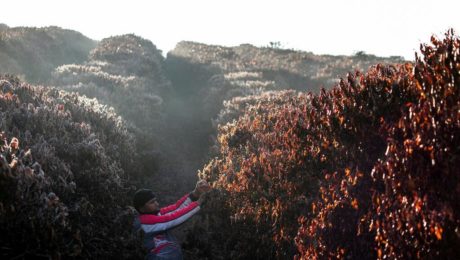Exploring Culinary Bubbles
Serious Eats features a series of articles on fermented drinks in their latest digital issue, “Bubbles.” Bubbles are the “negative space” in food which contribute to food flavor and fermentation. The long-form articles dive into kombucha, tepache, coffee and explore how the beer industry is adapting with a CO2 shortage.
“It’s easy to look past the pockets of air that occupy so much of what we eat, but food as we know it wouldn’t be recognizable without them,” reads the editor letter describing the new article series. “Bubbles inflate breads, lighten cakes and batters, aerate creams and mousses, and add fizz to so many drinks. They’re a byproduct of fermentation, a critical determinant of texture, the thing that makes your eyes water as you let out an Aaahhhhhhhhhh after that first spicy sip of cold soda or beer. So much of what defines our food is all the stuff that’s not there.”
Read more (Serious Eats)
- Published in Food & Flavor
Bean-free Chocolate & Coffee
The front page of the Financial Times featured a new wave of alternative foods: chocolate and coffee, but without the beans.
Cultivating both cocoa beans for chocolate and coffee cherries for coffee at such a high rate for global consumption is damaging to the environment. It’s linked to deforestation. The working conditions for many of the farmers are also deplorable, with child and slave labor and poor wages. Now multiple startups are trying to make a market for bean-free products.
“You realise that a lot of our favourite foods, whether it’s beef burgers or a cult of coffee or a chocolate bar, there’s so much damage,” said Johnny Drain, chief technology officer of WNWN Food Labs, a London-based maker of cocoa-free chocolate. “Not just to the climate but to the people, typically in developing countries who are producing those products for us.”
Drain is a fermentation expert who formerly worked with restaurants to make unique flavor profiles using fermentation. He’s founded WNWN with Ahrum Pak, a former financier now working in the foodtech space with Drain (both pictured). Their chocolate is made from fermented barley and carob.
More startups are, too, trying to be a solution to an unhealthy chocolate and coffee industry. In Munich, Planet A developed a cocoa-free chocolate which has chief ingredients of fermented oats and sugar beet. They call it “Nocoa.” In the U.S., Voyage Foods and California Culture make chocolate from lab-grown cocoa.
Bean-free coffee, meanwhile, has been created by two U.S. startups – Atomo in Seattle uses date seeds, chicory root, grape skin and green tea to create a canned cold brew coffee. Compound Foods in San Francisco. The latter is recreating coffee using synthetic biology and fermentation.
“We want to give consumers a choice,” said Andy Kleitsch, co-founder of Atomo, who added that although they had been worried that “the coffee industry would hate us or that the baristas might hate us, the reception has been positive”.
Many of these entrepreneurs note alt products are not the only solution to an environmentally-damaging food industry. Drain adds: “It’s just one additional way of trying to change an industry that is built on inequity and slave labour.”
Read more (Financial Times)
- Published in Business, Food & Flavor
Endangered Fermented Foods
Through selective breeding and domestication of plants and livestock, the world’s food system has lost diversity to an alarming degree. Crops are monocultures and animals are single species. Journalist and author Dan Saladino argues it’s vital to the health of humanity and our planet to save these traditional foods.
“There’s an incredible amount of homogenization taking place in the last century, which has resulted in a huge amount of concentration of power in the food system but also a decline in the amount of biodiversity,” says Saladino, author of Eating to Extinction. “That agricultural and biological diversity is disappearing and it’s taken us thousands, millions of years for plant, animal evolution to get to this point.”
Saladino was a keynote speaker at The Fermentation Association’s conference FERMENTATION 2022, his first in-person talk in the United States since his book was released in February. A journalist with the BBC, Saladino was also an active participant in the event, attending multiple days’ worth of educational sessions. He called the conference “mind expanding.”
“I thought I knew about fermentation, when in fact I know very little,” Saladino said to the crowd in his keynote. “We’ve been bemused by the media reports that fermentation is a fad or fashion. What we know is that the modern food system in the last 150 years is the fad. It’s barely a blip in the context of our evolution as species, and it’s the way we’ve survived as a species over thousands of years.”
Eating to Extinction includes 40 stories of endangered foods and beverages, just touching on a fraction of what is happening around the world. To date, over 5,000 endangered items from 130 different countries have been cataloged by the Slow Food Foundation’s project the Ark of Taste.
During FERMENTATION 2022, Saladino centered his remarks around the endangered fermented foods he chronicled in his book – Salers cheese, skerpikjøt, oca, O-Higu soybeans, lambic beer, pu’erh tea, qvevri wine, perry and wild forest coffee. Here are some of the highlights of his presentation.
Salers cheese (Augergne, Central France)
Fermentation was a survival strategy for many early humans, a fact especially evident in the origins of cheesemaking. In areas like Salers in central France, villagers live in inhospitable mountain areas where it’s difficult to access food. In the spring each year, cheesemakers travel up the mountains with their cattle and live like nomads for months.
“It’s extremely laborious, hard work,” Saladino says, noting there’s only a handful of Salers cheese producers left in France. He marvels at “the ingenuity of taking animals up and out to pasture in places where the energy from the sun and from the soil is creating pastures with grasses with wildflowers and herbs and so on.”
Unlike with modern cheese, no starter cultures are used to make Salers cheese. The microbial activity is provided by the environment – the pasture, the animals and even the leftover lactic acid bacteria in the milk barrels. Because of diversity, the taste is rarely consistent, ranging season to season from mild to aggressive.
“The idea of cheesemaking is a way humans expand and explore these new territories assisted by the crucial characters in this: the microbes,” he adds. “It can be argued that cheese is one of most beautiful ways to capture the landscape of food – the microbial activity in grasses, the interaction of breeds of animals that are adapted to the landscape. It’s creating something unique to that place.”
Skerpikjøt (Faroe Islands)
Skerpikjøt “is a powerful illustration to our relationship with animals, with meat eating,” Saladino says. It is fermented mutton and unique to Denmark’s Faroe Islands. Today’s farmers selectively breed their sheep for ideal wool production, then slaughter the lambs for meat. In the Faroes, “the idea of eating lamb was a relatively new concept.” Sheep are considered vital to the farm as long as they’re still producing wool and milk.
Once a sheep dies or is killed, the mutton carcass is air-dried and fermented in a shed for 9-18 months. The resulting product is “said to be anything between Parmesan and death. It certainly has got a challenging, funky fragrance,” Saldino says.
But it contrasts traditional and modern food practices. Skerpikjøt is meant to be consumed in small quantities, delicate slivers of animal proteins used as a garnish. Contemporary meat is served in large portions and meant to be consumed quickly.
Oca (Andes, Bolivia),
In the Andes – “one of the highest, coldest and toughest places on Earth to live” – humans have relied on wild plants like oca, a tuber. After oca is harvested, it’s taken to the Pelechuco River. Holes are dug on the riverbank, then filled with water, hay and muna (Andean mint). Sacks of oca are placed in the holes, weighted down by stones, and left to ferment for a month. This process is vital as it leaches out acid.
“Through processing, this becomes an amazing food,” Saladino says.
But cities are demanding certain types of potatoes, encouraging remote villagers to plant monocultures of potatoes which are prone to diseases. The farmers end up in debt, buying fertilizers and pesticides to grow potatoes.
“For thousands of years, oca and this fermentation technique and the process to make these hockey pucks of carbohydrates and energy kept them alive in that area,” Saladino says. “It’s a diversity that is fast disappearing from the Andes.”
O-Higu soybeans (Okinawa, Japan)
The modern food industry is threatening the O-Higu soybean, too. It was an ideal soybean species – fast-growing, so it can be harvested before the rainy season and the arrival of insects.
“But by the 20th century, the soy culture pretty much disappeared,” Saladino says.
With World War II came one of America’s biggest military bases to Japan. U.S. leaders dictated what food could be planted on the island. Okinawa was self-sufficient in local soy until American soy was introduced.
Lambic Beer (Belgium)
Saldino explained that, after a spring/summer harvest, Belgian farmers became brewers. They used their leftover wheat to create brews unique to the region.
But by the 1950s and 1960s, larger brewers began buying up the smaller ones. Anheuser-Busch InBev now produces one in four beers drunk around the world.
“There [is] story after story of these distinctive, unique, small breweries disappearing as they are bought up or absorbed into this growing, expanding empire of brewing,” Saladino says. “It’s probably one of the most striking cases of corporate consolidation of a drink and food product.”
Saladino stressed not all is lost. He shared stories of scientists, researchers and local people trying to save endangered foods, collecting seeds, restoring crops and combining traditional and modern-day practices to preserve the world’s rare foods.
“There have been so many fascinating stories of science and research discussed over the last few days at this conference, and I think the existence of The Fermentation Association is exciting because it is bringing together tradition, culture, science, culinary skills, all of these things we know food is,” Saladino added. “Food is economics, politics, geography, anthropology, nutrition. What I’m arguing is that these clues or glimpses into the past for these endangered foods, they’re not just some kind of a food museum or an online catalog. They are the solutions that can help us resolve some of the biggest food challenges we have.”
- Published in Food & Flavor
Fermentation Takes Center Stage in the Coffee Industry
Coffee production is an enormous, global industry, but the fermentation of coffee beans has not been a major focus for producers — until now. Highlighting the scope of the industry and this new emphasis on the impact of fermentation, The Fermentation Association’s webinar El Estado Del Arte En La Fermentación Del Café generated registrations from around the world. Registrations were nearly twice what TFA’s largest webinar generated.
TFA’s first Spanish-language webinar, the final count of registrants was well over 1,000, and came from 42 countries. The continents of North and South America, Europe, Africa, Asia and Australia were all represented. Registrations from key coffee-growing areas — Colombia, Mexico, Peru and Honduras — accounted for 70% of those that signed up. But we had folks from Ethiopia, Belgium, Nepal, Laos and the United Arab Emirates as well!
TFA partnered with the Specialty Coffee Association (SCA) last year and produced a webinar in August entitled The State of the Art in Coffee Fermentation. SCA’s Technical Officer, Dr. Mario Fernandez, brought together two esteemed speakers in the industry that discussed different approaches to fermentation. Felipe Ospina, CEO of Colors of Nature Group, and Ruben Sorto, CEO of BioFortune Group, represented two sides of the subject. At the risk of oversimplifying, Ospina favors traditional, natural fermentation methods. Sorto is investing in how to apply the technologies and processes from other food and beverage production industries — like winemaking, for example — to enhance the end product. Ospina connected from offices in Japan; Sorto spoke from his Honduras operations.
These speakers also were part of last year’s English-language webinar on the same subject and with the same speakers. The response to that session was so overwhelmingly positive that it led us to reprise the session, but to do it this time in Spanish. It was a bit challenging for our non-Spanish-speaking TFA team, but we were helped out enormously by our colleague from Monterrey, Mexico, Raquel Guajardo, a fermentation author, educator and entrepreneur. Dr. Fernandez, after being instrumental in planning and promoting both sessions, was called away suddenly on the day of this webinar. Ms Guajardo filled in admirably as our last-minute replacement moderator.
We look forward to more collaborations with SCA. Watch for another joint effort in late April/early May, after SCA’s Specialty Coffee Expo in Boston, April 8-10.
- Published in Business, Food & Flavor
Asian American Entrepreneurs React to Online Trolls
Racist and sexist comments have long been hurled at food companies run by Asian American women. But in the modern tech era, where food brands have a social media presence, these cruel remarks from trolls are being dealt with in a variety of ways. Some fight back with humor, others aim to educate while some ignore it.
Kim Pham, co-founder (with her sister Vanessa) of Omsom (which sells Asian pantry staples), said it was difficult in the brand’s early days for her to read offensive comments. She came to a sad realization: “I think it’s par for the course when you are an outspoken brand run by women of color.”
“For so long our community has been defined by this model minority myth, of being quiet, or docile, or submissive,” said Pham, “and we really just wanted to give a middle finger to that.”
Omsom’s social media policy is to remove insulting comments, but leave anything that “might generate a fruitful conversation.”
Jing Gao of Fly By Jing (which sells Asian pantry staples, dumplings and hot pots) (pictured), though, takes a different approach. “We have no problem making fun of those people who are, you know, clearly disturbed,” said Jing Gao, the company’s 34-year-old founder, adding “We definitely troll them. … and our community seems to really love it.”
Meanwhile Sahra Nguyen, founder of Nguyen Coffee Supply, has zero tolerance for trolls. She doesn’t want her employees engaging in toxic behavior, so they don’t respond.
Read more (The New York Times)
- Published in Business
Changing Face of Specialty Coffee
Gesha (or Geisha) coffee has been the favored variety in coffee competitions for over 15 years. But recently specialty coffee brewers are using a new variety: the species C. eugenioides. An article in Perfect Daily Grind details the shift.
As Gesha became the preferred choice of coffee champions (seven of the World Brewers Cup (WBrC) champions from 2011 to 2019 used Gesha), the price started to rise. Gesha production, common in Panama, began to increase in other countries wanting to farm the popular variety, notably Colombia and Ethiopia. But increased production led to some lower-quality Geshas coming to market.
In recent years, producers have opted for lesser-known coffees, notably eugenioides, a species of arabica originating in East Africa. Its flavor profile is unique, with notes of tropical fruit, and has lower levels of caffeine. But it can be a risky variety. Eugenioides trees are small and produce small cherries, and they take years to grow.
A possibly more sustainable option for the industry: innovative processing techniques. The 2015 WBrC winner won using carbonic maceration process, a fermentation technique used in the wine industry.
“Fermentation is an effective way to influence the aroma and taste of coffee. It changes the acidity levels and body of coffee,” explains Chad Wang, founder of VWI by Chad Wang, a specialty coffee judge and the 2017 WBrC winner. “Fermentation can significantly help coffee farms to offer different tastes without having to change too much.”
[To learn more about fermentation in coffee, check out TFA’s webinar with the Specialty Coffee Association “The State of the Art in Coffee Fermentation.” The two organizations will be partnering again for a Spanish language version of the free webinar on March 3.]Read more (Perfect Daily Grind)
- Published in Food & Flavor
The Rise of Fermented Foods and -Biotics
Microbes on our bodies outnumber our human cells. Can we improve our health using microbes?
“(Humans) are minuscule compared to the genetic content of our microbiomes,” says Maria Marco, PhD, professor of food science at the University of California, Davis (and a TFA Advisory Board Member). “We now have a much better handle that microbes are good for us.”
Marco was a featured speaker at an Institute for the Advancement of Food and Nutrition Sciences (IAFNS) webinar, “What’s What?! Probiotics, Postbiotics, Prebiotics, Synbiotics and Fermented Foods.” Also speaking was Karen Scott, PhD, professor at University of Aberdeen, Scotland, and co-director of the university’s Centre for Bacteria in Health and Disease.
While probiotic-containing foods and supplements have been around for decades – or, in the case of fermented foods, tens of thousands of years – they have become more common recently . But “as the terms relevant to this space proliferate, so does confusion,” states IAFNS.
Using definitions created by the International Scientific Association for Postbiotics and Prebiotics (ISAPP), Marco and Scott presented the attributes of fermented foods, probiotics, prebiotics, synbiotics and postbiotics.
The majority of microbes in the human body are in the digestive tract, Marco notes: “We have frankly very few ways we can direct them towards what we need for sustaining our health and well being.” Humans can’t control age or genetics and have little impact over environmental factors.
What we can control, though, are the kinds of foods, beverages and supplements we consume.
Fermented Foods
It’s estimated that one third of the human diet globally is made up of fermented foods. But this is a diverse category that shares one common element: “Fermented foods are made by microbes,” Marco adds. “You can’t have a fermented food without a microbe.”
This distinction separates true fermented foods from those that look fermented but don’t have microbes involved. Quick pickles or cucumbers soaked in a vinegar brine, for example, are not fermented. And there are fermented foods that originally contained live microbes, but where those microbes are killed during production — in sourdough bread, shelf-stable pickles and veggies, sausage, soy sauce, vinegar, wine, most beers, coffee and chocolate. Fermented foods that contain live, viable microbes include yogurt, kefir, most cheeses, natto, tempeh, kimchi, dry fermented sausages, most kombuchas and some beers.
“There’s confusion among scientists and the public about what is a fermented food,” Marco says.
Fermented foods provide health benefits by transforming food ingredients, synthesizing nutrients and providing live microbes.There is some evidence they aid digestive health (kefir, sourdough), improve mood and behavior (wine, beer, coffee), reduce inflammatory bowel syndrome (sauerkraut, sourdough), aid weight loss and fight obesity (yogurt, kimchi), and enhance immunity (kimchi, yogurt), bone health (yogurt, kefir, natto) and the cardiovascular system (yogurt, cheese, coffee, wine, beer, vinegar). But there are only a few studies on humans that have examined these topics. More studies of fermented foods are needed to document and prove these benefits.
Probiotics
Probiotics, on the other hand, have clinical evidence documenting their health benefits. “We know probiotics improve human health,” Marco says.
The concept of probiotics dates back to the early 20th century, but the word “probiotic” has now become a household term. Most scientific studies involving probiotics look at their benefit to the digestive tract, but new research is examining their impact on the respiratory system and in aiding vaginal health.
Probiotics are different from fermented foods because they are defined at the strain level and their genomic sequence is known, Marco adds. Probiotics should be alive at the time of consumption in order to provide a health benefit.
Postbiotics
Postbiotics are dead microorganisms. It is a relatively new term — also referred to as parabiotics, non-viable probiotics, heat-killed probiotics and tyndallized probiotics — and there’s emerging research around the health benefits of consuming these inanimate cells.
“I think we’ll be seeing a lot more attention to this concept as we begin to understand how probiotics work and gut microbiomes work and the specific compounds needed to modulate our health,” according to Marco.
Prebiotics
Prebiotics are, according to ISAPP, “A substrate selectively utilized by host microorganisms conferring a health benefit on the host.”
“It basically means a food source for microorganisms that live in or on a source,” Scott says. “But any candidate for a prebiotic must confer a health benefit.”
Prebiotics are not processed in the small intestine. They reach the large intestine undigested, where they serve as nutrients for beneficial microorganisms in our gut microbiome.
Synbiotics
Synbiotics are mixtures of probiotics and prebiotics and stimulate a host’s resident bacteria. They are composed of live microorganisms and substrates that demonstrate a health benefit when combined.
Scott notes that, in human trials with probiotics, none of the currently recognized probiotic species (like lactobacilli and bifidobacteria) appear in fecal samples existing probiotics.
“There must be something missing in what we’re doing in this field,” she says. “We need new probiotics. I’m not saying existing probiotics don’t work or we shouldn’t use them. But I think that now that we have the potential to develop new probiotics, they might be even better than what we have now.”
She sees great potential in this new class of -biotics.
Both Scott and Marco encouraged nutritionists to work with clients on first improving their diets before adding supplements. The -biotics stimulate what’s in the gut, so a diverse diet is the best starting point.
Fermenting Coffee with Koji?
A two-time Finnish Barista Champion made headlines with his unique cup of joe at the World Barista Championship in Italy — a koji-fermented coffee.
Aiming to make better coffee than what’s available on the market, Kaapo Paavolainen (pictured) studied how he could maximize the flavor in coffee beans. “Sugar in beans is responsible for coffee’s inherent sweetness but the lack of it results in unpleasant bitterness. But the current methods can extract only 70% of available sugar,” he told Forbes.
After reading about koji in the books Koji Alchemy (by Jeremy Umansky and Rich Shih) and The Noma Guide to Fermentation (by Rene Redzepi and David Zilber), he realized koji can tap into the remaining 30% of sugar in beans.
Incredibly, this koji-based method was used on subpar coffee beans in experiments and still transformed the coffee. Umansky described the flavor as “deep, earthy and leathery. Depending on the roasting level of the beans, the flavor ranged widely from tropical fruits like pineapple and mango to chocolate and gingerbread. The mouthfeel was strikingly silky and luxurious like butter. The rounded, full-bodied texture made these tastes last very long.”
Paavolainen aims to scale the koji process with a partner farm in Columbia. This new coffee method could aid coffee farmers, many of whom are financially challenged and are struggling to maintain farms in the face of climate change.
Read more (Forbes)
- Published in Business, Food & Flavor
The Brewing Coffee-Farming Crisis
Many pressures are building on coffee farmers, making their jobs increasingly difficult. Climate change is causing numerous impacts — temperatures are rising, rainfall is increasingly unpredictable, weather can swing from drought to flood, and new crop pests are emerging. And these problems are on top of existing environmental concerns, as growing coffee requires large amounts of water.
Further, studies show that, even with “modest declines of greenhouse gas emissions, about 50 percent of the land with conditions suitable for growing the two main species of coffee, arabica and robusta, which account for 99 percent of commercial supply, ‘could disappear by 2050.’ Brazil and Vietnam, major producing countries, would be especially hard hit.”
The Times details several organizations’ efforts to aid coffee farmers by restoring and protecting water resources, supporting more efficient use of water, improving crop yields with targeted fertilization and starting a global breeding network for new coffee species that can withstand tough climates.
Read more (The New York Times)
The State of the Art in Coffee Fermentation
More specialty coffee producers are developing unique approaches to their coffee bean fermentation, isolating native microorganisms to create a flavorful cup or working closely with rural farmers to utilize fermentation control techniques on small-scale operations.
“Practically all the coffee we drink has been fermented in one way or another. But there is huge room for improvement, innovation and development in the realm of coffee fermentation,” says Mario Fernández, PhD, Technical Officer with the Specialty Coffee Association (SCA). The SCA partnered with The Fermentation Association for the webinar The State of the Art in Coffee Fermentation.
Fernández continues: “Coffee is produced by millions of small coffee producers around the tropics that have very little capital to invest in fermentation equipment. Oftentimes, the price is too low for them to add fermentation controls as part of the cost equation. Therefore, for perhaps 99.9% of coffee in the world, it undergoes wild fermentation, in which the microbes grow on the mass of mucilage in a wild fashion and the coffee producer only controls certain parameters, such as the length of the fermentation.”
Two industry experts on the forefront of coffee fermentation technique and technology joined Fernández — Felipe Ospina, CEO of Colors of Nature Group (multinational specialty coffee trader) and Rubén Sorto, CEO of BioFortune Group (a coffee, upcycled and food ingredient manufacturer based in Honduras).
Post Harvest Processing Technology
Sorto is adapting fermentation technology to coffee, mapping the microbiota of the bacteria and yeasts that are present at Biofortune Group’s farms.
“We realized that fermentation was one of the key aspects of the coffee production that hadn’t been addressed,” Sorto said, noting fermentation is controlled in industries like dairy, wine, beer and bread but not in coffee. “We learned that our soil, our water, our coffee trees, our leaves, our [coffee] cherries, had a large compendium of bacteria and yeast that were involved in the posterior fermentation process…some of the yeasts and bacteria were definitely beneficial and were urgently needed during the fermentation but some of them were not.”
To maximize flavor, they focus on that complex array of bacteria and yeasts, preferably indigenous to the countries of origin. These microorganisms thrive in their local environment, reflecting altitude and temperature. To control the fermentation of those bacteria and yeasts, Biofortune reduces the variables, including monitoring pH levels, alcohol content and container contaminants.
“If you are able to control the fermentation, you are also able to offer a higher-quality product, a consistent quality product…and that’s what the market is looking for, consistent quality in a cup,” Sorto says.
Educating Coffee Farmers
Ospina, meanwhile, is researching fermentation techniques accessible to small-holder coffee producers and training them. The goal is for them to understand the role of each microorganism, discover how to use it in fermentation, then scale that knowledge to small-scale operations, so they can produce incredible coffees.
At La Cereza Research Center, the Colors of Nature facility in southern Colombia, they are experimenting with fermentation processes. Some alcoholic fermentations result in coffees that produce coffees that taste of whiskey, cognac, champagne, sangria or even beer. Lactic fermentations might produce coffees with flavors of banana, mango, papaya, grapefruit or even cacao. “This is showing us the potential is humongous,” Ospina says.
“Wild fermentation is the ultimate expression of the terroir and it’s very important for us because the terroir produces unique coffees,” Ospina says. “The thing is, we don’t understand wild fermentation yet, but I’m very against demonizing wild fermentation. Why? Because we have seen hundreds and hundreds of outstanding, amazing coffees from all over the world that have been produced with wild fermentation.”
There are challenges. Food safety is a big concern. Ospina teaches the use of disposable gloves at the farm level to prevent contaminants, and to put a new plastic bag in the bioreactor for each batch of beans to avoid cross-contamination.
The cost of implementing fermentation technology can be high. Sorto recommends to start by buying each farmer a pocket pH meter and a refractometer to closely monitor the fermentation.
“Translating science and technology to small farmers with very little investment will help them increase the possibility of a higher income because if you are not able to control fermentation, you are risking the effort of a one year harvest,” Sorto advises.
- Published in Business, Food & Flavor










